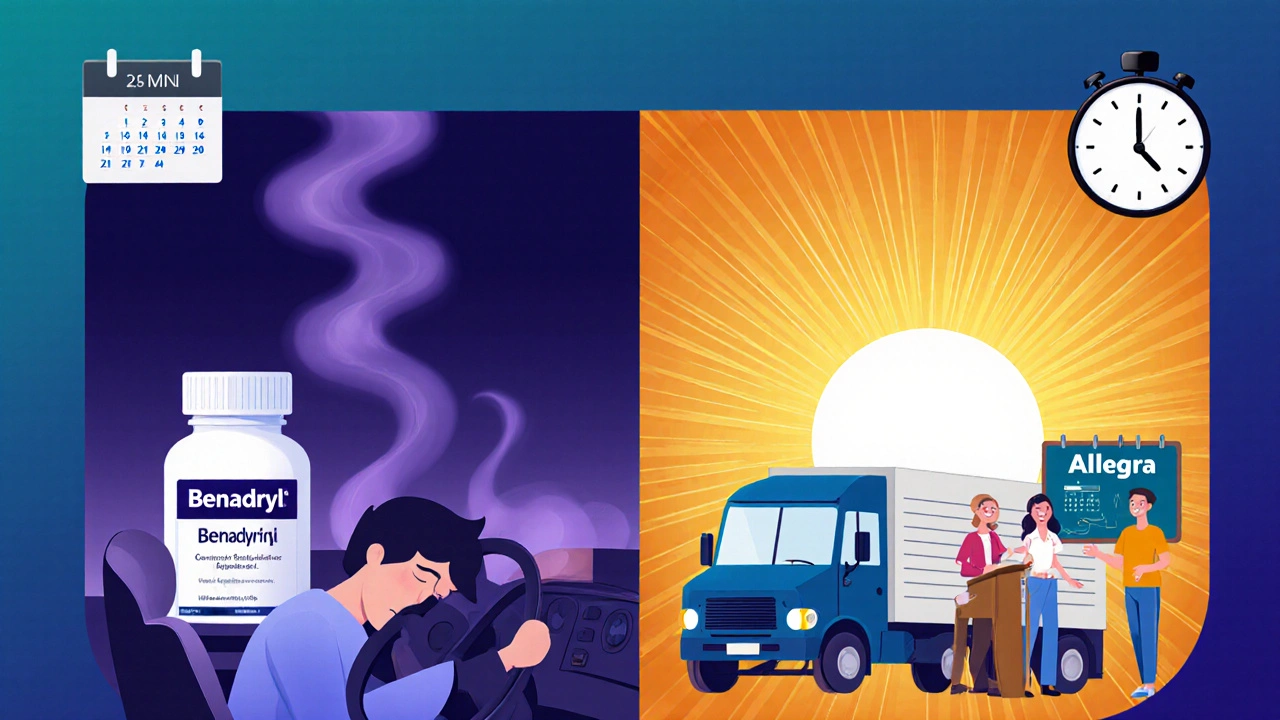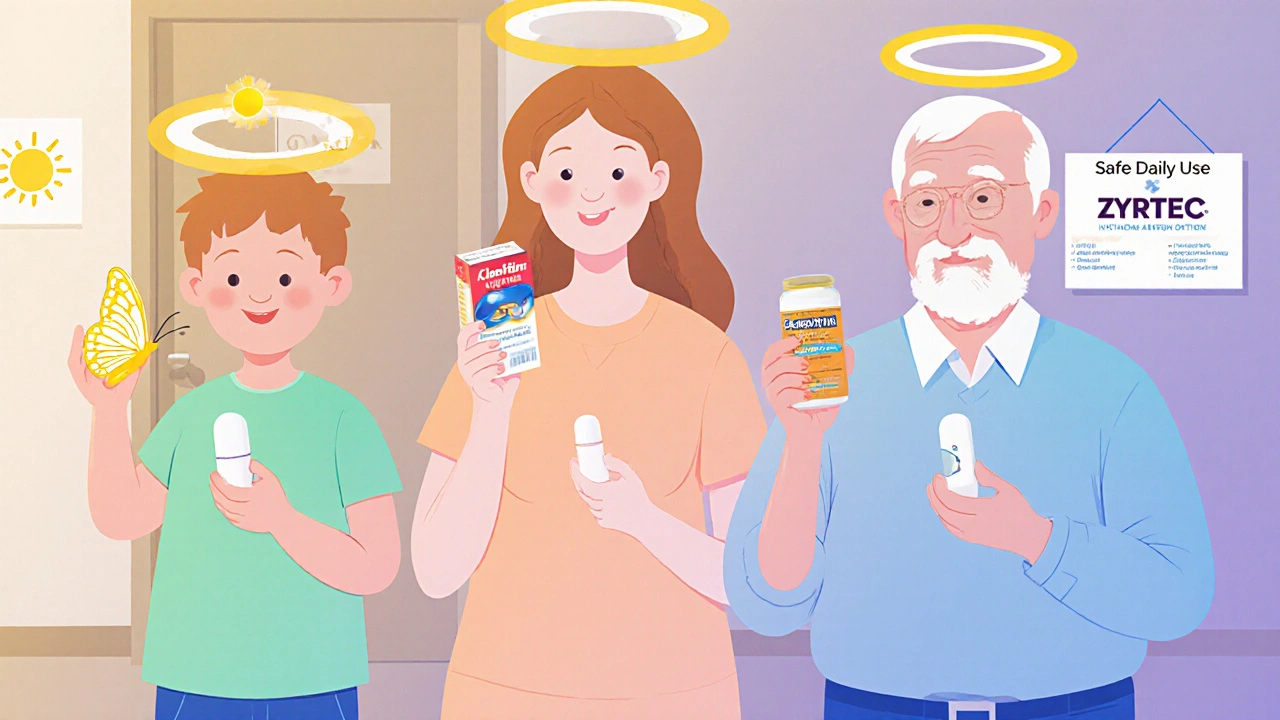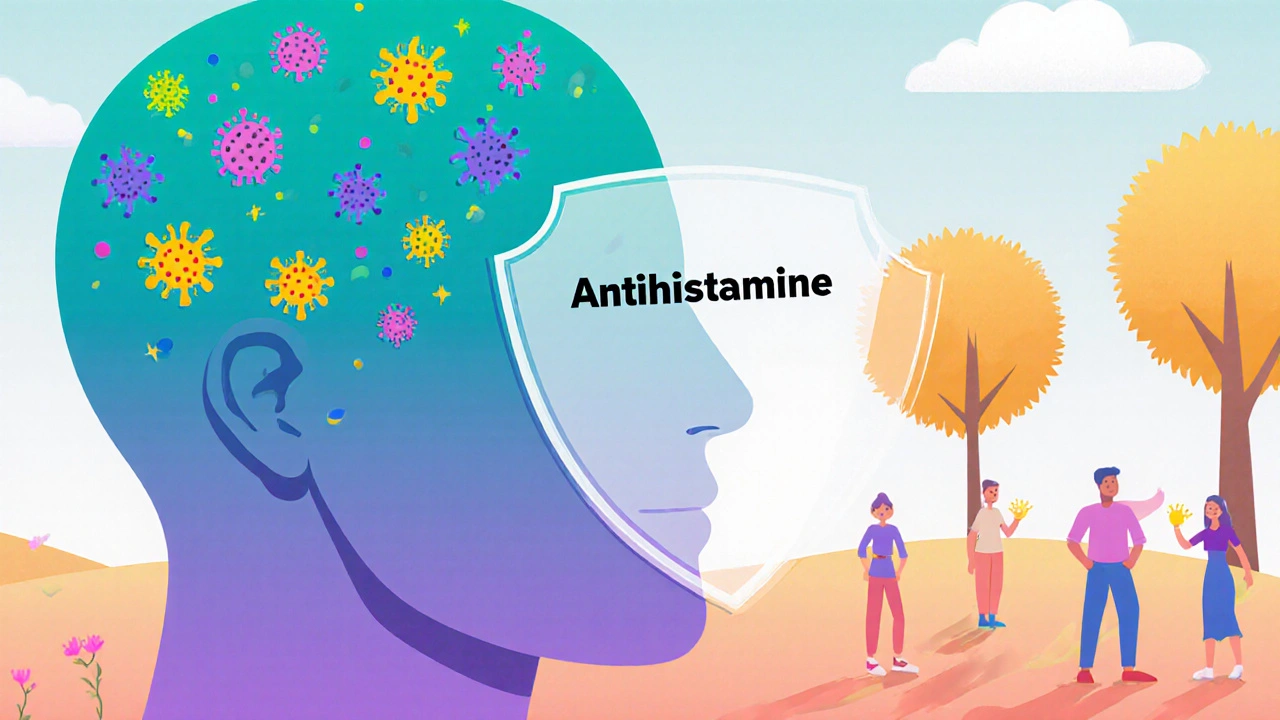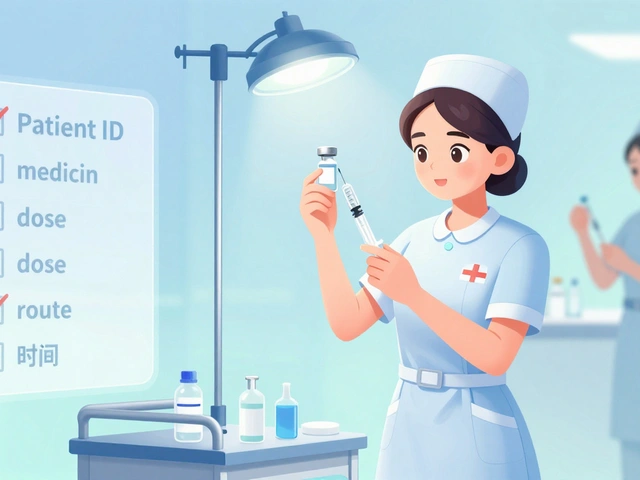What Antihistamines Actually Do
When you sneeze, your nose runs, or your eyes itch because of pollen, dust, or pet dander, your body is releasing histamine. It’s not the allergen itself causing the mess-it’s your immune system overreacting and flooding your tissues with this chemical. Antihistamines step in to block histamine from binding to its receptors, which stops the symptoms before they get out of hand. These aren’t just quick fixes; they’re the most common first-line treatment for allergies in the U.S., with over 87% of the $3.2 billion OTC allergy market made up of these pills and liquids.
First-Generation vs. Second- and Third-Generation: The Big Difference
Not all antihistamines are created equal. The big split is between older, sedating versions and newer, non-sedating ones. First-generation antihistamines like diphenhydramine (Benadryl), chlorpheniramine (Chlor-Trimeton), and doxylamine (Unisom) cross the blood-brain barrier easily. That’s why they make you drowsy-about half of users feel it. In fact, studies show they can impair driving as much as a 0.10% blood alcohol level. These were developed in the 1940s and still show up in sleep aids and cold medicines, but they’re not ideal for daily allergy control.
Second- and third-generation antihistamines like cetirizine (Zyrtec), loratadine (Claritin), and fexofenadine (Allegra) were designed differently. They’re less likely to enter the brain, so they don’t cause the same level of drowsiness. That’s why they’re the go-to for people who need to stay alert-truck drivers, surgeons, teachers, and parents with kids in school. These became available over-the-counter in the U.S. after FDA reviews confirmed their safety and effectiveness for daily use. They also last 24 hours, so you only need one pill a day.
Which One Works Best? A Real-World Breakdown
There’s no single best antihistamine for everyone. Your body reacts differently than someone else’s. But here’s what the data and real users say:
- Fexofenadine (Allegra): Lowest risk of drowsiness. Only 6% of users report feeling sleepy, compared to 14% for Zyrtec and 18% for first-gen meds. It’s the top pick for people who can’t afford even mild fatigue. It starts working in 1-2 hours and lasts all day.
- Cetirizine (Zyrtec): Fast-acting, strong relief. But it causes drowsiness in about 14% of users, and some report feeling foggy by mid-afternoon. It’s effective for hives and runny nose, but if you’re sensitive to sedation, this might not be your best bet.
- Loratadine (Claritin): Consistently rated 4.4 out of 5 on Amazon. Over 80% of 5-star reviews say it works without making them tired. It’s a solid, reliable choice with a long track record. Takes about an hour to kick in.
- Levocetirizine (Xyzal): A more potent version of Zyrtec. It’s slightly less sedating than Zyrtec, but still more likely to cause drowsiness than Allegra. The OTC label doesn’t include dosing for adults over 65-doctors recommend consulting a provider first because older adults are more sensitive to side effects.
On Reddit’s r/Allergies, users who tried all three say Allegra is the only one they can take without napping after lunch. Zyrtec gets called "effective but sleepy," and Claritin is "the one I can forget about."

When to Take Them (And When Not To)
Timing matters. Waiting until you’re already sneezing and itchy means you’re already behind. Experts recommend starting a second-generation antihistamine 1-2 weeks before allergy season kicks in. This lets the drug build up in your system and block histamine before it triggers a full reaction. It’s like putting on a raincoat before the storm hits-not after you’re soaked.
First-generation antihistamines? Save them for emergencies. If you get a sudden hive outbreak or a bad reaction, Benadryl works fast-within 15-30 minutes. But don’t use it daily. The drowsiness adds up. It can mess with your memory, slow your reaction time, and increase fall risk in older adults. The American Academy of Pediatrics says kids under 6 shouldn’t take them at all.
What You Shouldn’t Mix With Antihistamines
Some things make side effects worse. Grapefruit juice, for example, can increase the amount of certain antihistamines in your blood by up to 37%. That means more drowsiness, more dizziness, more risk. Avoid it if you’re taking Zyrtec, Claritin, or Allegra.
Alcohol? Don’t combine it with any antihistamine, especially first-gen. It multiplies the sedation. Even one drink with Benadryl can leave you groggy and unsteady. Same goes for sleeping pills, muscle relaxants, or anxiety meds. If you’re on any of these, talk to your pharmacist before taking an OTC allergy pill.
Special Groups: Kids, Seniors, and Pregnant People
For children under 6, first-generation antihistamines are off-limits. Second-gen options like Claritin and Zyrtec are approved for kids as young as 2, but always check the label for proper dosing based on weight and age.
For adults over 65, the rules get tighter. Your body processes drugs slower. Even non-sedating antihistamines can cause confusion or dizziness. Xyzal’s label doesn’t include adult dosing for this group for that reason. If you’re over 65 and need daily allergy relief, start with the lowest dose of Claritin or Allegra and watch how you feel. Talk to your doctor if you’re unsure.
During pregnancy, second-generation antihistamines are generally considered safer than first-gen. Claritin and Zyrtec are often recommended by OB-GYNs, but always check with your provider. There’s no perfect choice, but the risks from uncontrolled allergies (like poor sleep or stress) often outweigh the risks of these medications.

Long-Term Use: Is It Safe?
People take these pills for months-or years. Is that okay? So far, yes. Post-marketing surveillance through 2023 shows no major safety red flags for second-generation antihistamines used long-term. But there’s one caveat: a 2022 JAMA Internal Medicine review looked at older adults (over 75) who took first-gen antihistamines daily for years. It found a possible link to slightly higher dementia risk. That link wasn’t seen with Zyrtec, Claritin, or Allegra.
Still, we don’t have 20-year studies on daily use of non-sedating antihistamines. That doesn’t mean they’re dangerous-it just means we’re still learning. If you’re taking one every day for more than a year, it’s worth a check-in with your doctor. Are your symptoms under control? Could you reduce the dose? Is there another approach?
What to Do If Nothing Works
One in three people need to try two or three different antihistamines before finding one that clicks. That’s normal. Your body’s receptors respond differently. If Claritin doesn’t help, try Zyrtec. If Zyrtec makes you sleepy, switch to Allegra. If Allegra still doesn’t cut it, consider nasal sprays, eye drops, or allergy shots. The American College of Allergy, Asthma, and Immunology’s free helpline (1-800-842-7777) helps 12,000 people a year figure this out. Their online "Allergy Relief Finder" tool also lets you compare options based on your symptoms, schedule, and sensitivity to drowsiness.
What’s New in 2025?
The market keeps evolving. In April 2023, the FDA approved a new version of Allegra-D with extended-release pseudoephedrine-giving you 12 hours of decongestant relief along with 24-hour allergy control. Sanofi is preparing to launch a nasal spray version of rupatadine in 2024, which could offer faster relief for nasal symptoms without pills.
Overall, the trend is clear: people want effective relief without the fog. The non-sedating antihistamine market is expected to grow 5.2% a year through 2028, driven by more Americans developing allergies (50 million now) and greater awareness of cognitive side effects. For now, second- and third-generation antihistamines remain the gold standard-and they’re not going anywhere soon.
Can I take antihistamines every day?
Yes, second- and third-generation antihistamines like Claritin, Zyrtec, and Allegra are safe for daily use. They’re designed for long-term allergy management. First-generation options like Benadryl should not be taken daily due to drowsiness and cognitive side effects. If you’re using an OTC antihistamine every day for more than a year, it’s a good idea to check in with your doctor to make sure it’s still the best option.
Which antihistamine causes the least drowsiness?
Fexofenadine (Allegra) causes the least drowsiness among OTC antihistamines. Clinical studies show only about 6% of users report feeling sleepy, compared to 14% for cetirizine (Zyrtec) and up to 18% for first-generation options like diphenhydramine. It’s the top choice for people who need to stay alert-drivers, healthcare workers, or anyone who can’t afford to feel foggy.
Why does Zyrtec make me sleepy but Claritin doesn’t?
Even though both are second-generation antihistamines, cetirizine (Zyrtec) has a slightly higher tendency to cross the blood-brain barrier than loratadine (Claritin). Studies show Zyrtec causes measurable drowsiness in about 14% of users, while Claritin does so in only 6-8%. It’s not a guarantee-some people feel nothing from Zyrtec, while others feel it strongly. Everyone’s body reacts differently.
Can I give antihistamines to my child?
First-generation antihistamines like Benadryl are not recommended for children under 6 due to risks of sedation, breathing problems, and accidental overdose. Second-generation options like Claritin and Zyrtec are approved for kids as young as 2, but dosing must be based on weight and age. Always check the label or ask your pediatrician. Never use adult formulations for children.
Is it safe to take antihistamines with alcohol?
No. Alcohol increases drowsiness and dizziness from all antihistamines, especially first-generation ones. Even one drink with Benadryl can leave you unsteady. With non-sedating options like Allegra, the risk is lower-but combining alcohol with any antihistamine still reduces alertness and reaction time. It’s best to avoid alcohol entirely when taking these medications.
Do antihistamines help with sinus congestion?
Antihistamines alone don’t directly reduce nasal congestion. They’re great for sneezing, itching, and runny nose-but not for a stuffy nose. For congestion, you need a decongestant like pseudoephedrine. That’s why products like Allegra-D or Claritin-D combine an antihistamine with a decongestant. If you’re only taking an antihistamine and still feel blocked, you might need a different approach.
Can antihistamines cause weight gain?
Some people report weight gain while taking antihistamines, especially first-gen ones. This might be due to increased appetite or slowed metabolism from drowsiness. Second-generation antihistamines like Claritin and Allegra are less likely to cause this. If you notice unexplained weight gain, talk to your doctor-it could be related to the medication, or it could signal another issue like thyroid changes or fluid retention.
What should I do if my antihistamine stops working?
It’s not uncommon for your body to respond less over time. Try switching to a different antihistamine-many people find relief by switching from Zyrtec to Allegra or vice versa. If that doesn’t help, consider adding a nasal steroid spray, which works differently and is often more effective for congestion. If symptoms persist, see an allergist. You might need allergy testing or immunotherapy (shots or tablets) for long-term control.







Manjistha Roy
November 21, 2025 AT 16:51